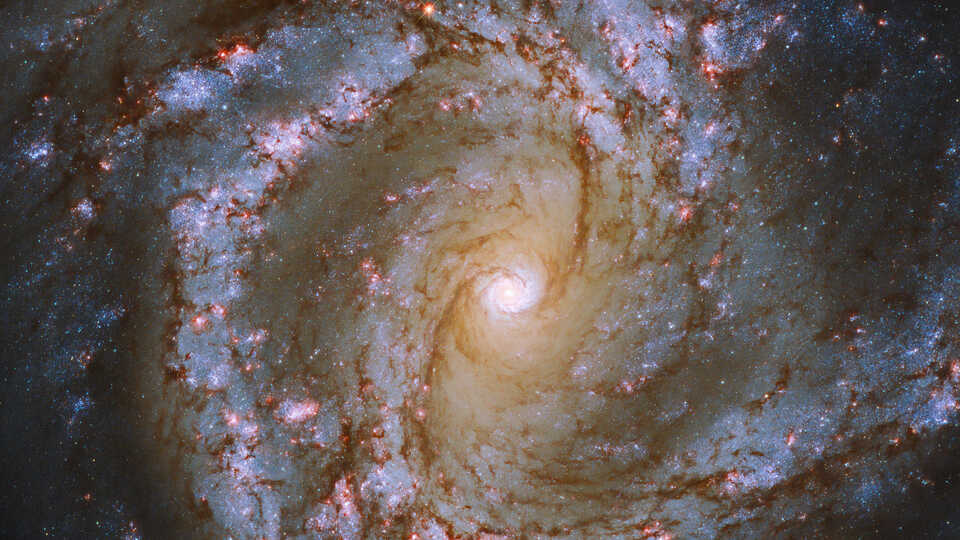The Benjamin Dean lecture series brings the world's leading experts in astronomy, astrophysics, and more to the Academy's Morrison Planetarium.

The luminous heart of the galaxy M61 as seen by the Hubble Space Telescope, with spiral arms studded with ruby-red patches of light—tell-tale signs of recent star formation!
In this week’s articles about the 243rd American Astronomical Society meeting, we’ve talked a lot about stars dying. What’s left behind afterward and how they seed the Universe with new elements. But stars are born as well! (Kind of goes hand-in-hand.)
The meeting came to a close yesterday, but we have one more story to share!
At one of Thursday’s plenary talks (when astronomers crowd together to hear an expert expound on a topic of general interest), Karin Sandstrom from the University of California, San Diego, described using JWST to explore star formation in nearby galaxies. The space-based telescope’s remarkable sensitivity and resolution have made distant objects much easier to study.
As Sandstrom put it, “The Local Group is the new Milky Way! And ʻnearby’ galaxies are the new Local Group.” In other words, just like orange is the new black, the ability to study our Local Group of galaxies (the fifty or so closest to us) can now leverage the same techniques that have been used to study the Milky Way… And techniques that were once used for the Local Group can now be used to study galaxies ten times farther away.
Sandstrom is one of the core members of a team working on the Physics at High Angular Resolution in Nearby Galaxies (PHANGS) survey, which is making high-resolution observations of nearby galaxies with across a wide range of wavelengths of light. The survey leverages observations byALMA,Hubble,JWST, and the Very Large Telescope (VLT). The goal is to understand how star formation processes in galaxies influences their overall structure and evolution.
The PHANGS team has published more than a hundred research papers, and they’ve shared some truly remarkable JWST images of galaxies (such as NGC1365 and NGC7496, to choose two examples). You can check out a whole gallery of images here.
In particular, Sandstrom pointed out that JWST is particularly well-designed to observed polycyclic aromatic hydrocarbons (PAHs), large organic molecules that could offer clues about how stars and planets form.
The PHANGS team focuses on objects that are all relatively nearby. But stars have been forming for almost the entire history of the Universe! And since light travels at a finite speed—300,000 kilometers (or 186,000 miles) per second—when we look out in space, we’re also looking back in time.
So if we want to understand how stars formed earlier in the history of the Universe, we just have to look at distant galaxies.
As Michael Calzadilla from the Massachusetts Institute of Technology put it, “The Universe really had its foot on the gas pedal about 10 billion years ago!”
Calzadilla and his team are interested in understanding how galaxies acquire the gas needed for star formation.
They make use of the South Pole Telescope (SPT), a 10-meter-diameter telescope that observes in microwave, millimeter, and sub-millimeter wavelengths of light. Those are low-energy wavelengths that detect the cool gas required for forming stars.
They then combine SPT data with data from the Chandra X-ray Observatory, a space-based mission that looks at short-wavelength, high-energy light, revealing the location of hot gas.
Finally, they captured spectra (I talked a bit about spectra on both Tuesday and Wednesday this week) to offer a more detailed glimpse into what’s happening…
They targeted 95 galaxy clusters spanning 10 billion years of the galactic evolution.
Calzadilla presented some preliminary results at the AAS meeting, with a clear conclusion that “the main driver of star formation in these huge galaxies really comes down to one thing—whether or not the hot gas surrounding them can cool off quickly enough,” he said.
The most recent AAS meeting cooled down quickly enough, drawing to a close yesterday and sending thousands of astronomers back home with new ideas about their research, new perspectives on the field of astronomy, and new colleagues to do more work understanding the cosmos.
The Benjamin Dean lecture series brings the world's leading experts in astronomy, astrophysics, and more to the Academy's Morrison Planetarium.